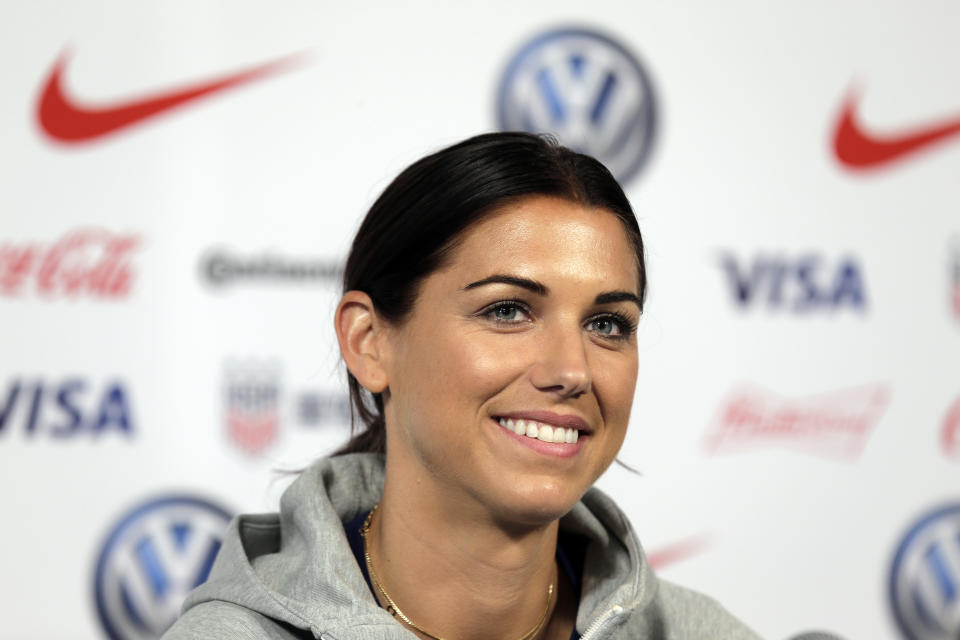Alex Morgan will try to play in 2020 Olympics per source, a chance safeguarded by past USWNT pregnancy case

Alex Morgan, one of the stars of the U.S. women’s national team, announced Wednesday that she and her husband are expecting a baby girl in April, three months before the start of the 2020 Olympics.
Fans of the USWNT were thrilled for her, of course, but the conversation quickly turned to Morgan’s job on the soccer pitch and the Tokyo Olympics: Will Morgan be back on the field in time? How does her pregnancy affect the USWNT roster?
Although Morgan hasn’t publicly spoken about her post-baby plans, a source very close to Morgan told Yahoo Sports that Morgan does intend to push herself back to the field, and her goal is to make the Olympic roster. Whether she’ll earn a spot will ultimately be up to the USWNT’s next coach, who has not yet been named.
But Morgan, like every USWNT player, will have the benefit of trying to earn her spot back after starting a family.
In the USWNT’s current collective bargaining agreement, which is not public but Yahoo Sports has obtained, once players are medically cleared to play after giving birth, they will be given call-ups for either a three-month period or two full USWNT camps. That gives players enough time to prove they belong back on the team.
The players also don’t have to worry about losing their national team income if they become pregnant. Pregnant players who are unable to play will earn 75% of their salary from U.S. Soccer and, if she’s an NWSL allocated player, she’ll earn 75% of that salary too until she’s medically cleared to play, or for up to a year, per the CBA.
Of course, this wasn’t always case and USWNT players had to fight to secure this protection.
As detailed in the book “The National Team,” USWNT defender Kate Markgraf — a former player and current U.S. Soccer general manager — had her USWNT contract yanked by former coach Pia Sundhage in 2009 after giving birth to twins. Because Markgraf hadn’t even been given a chance to compete at a training camp and show whether she belonged or not, then-USWNT lawyer John Langel urged her to sue the federation for pregnancy discrimination.

Markgraf eventually opted not to file a lawsuit; instead, she set out to prove she still belonged on that team. She did exactly that, winning back her spot and later retiring on her own terms at 201 caps for the United States.
But from that point forward, the USWNT’s contract with the federation included provisions to allow players to win their spots back on the team after giving birth — nicknamed the “Markgraf Rule” — which has benefitted many players over the years, and will ensure Morgan can ease her way back into the USWNT.
The best example may be striker Amy Rodriguez, who gave birth to her first child in 2013 and eventually made the World Cup-winning squad in 2015. In fact, after having her first son, Rodriguez discovered perhaps the best form of her career, and she led her club to two NWSL championships. Likewise, Shannon Boxx gave birth in 2014 and made the 2015 Women’s World Cup roster.
For Morgan, however, the window of time between giving birth and returning to the field will be a small one if she hopes to make the roster for the Tokyo Olympics. But it’s possible.
Earlier this year, former USWNT striker Sydney Leroux returned to her club, the Orlando Pride, 93 days after giving birth to her second child. Leroux continued training with the Pride while pregnant but eventually had to step away. As Leroux joked: “When I couldn’t take a shot without peeing, I knew it was time.”
[ Follow Yahoo Soccer on Twitter and Facebook ]
The challenge for Morgan is twofold.
First, the Olympic roster is smaller and has less room for players who won’t make significant on-field contributions. Of the 23 women that competed in the World Cup in France, just 18 will head to Tokyo for the Olympics.
Second, Morgan won’t be able to compete with the team that is expected to qualify for the Olympics, and the coach may want to stick to the group that clinches a spot in Tokyo. The CONCACAF qualification tournament is typically held in January, although the dates have not been announced.
Still, Morgan has been one of the most valuable players on the USWNT and the centerpiece of the American attack. She won the Silver Boot at the 2019 Women’s World Cup and was named to FIFPro’s 2019 World Best XI, and the style of the U.S. attack is largely built around getting the ball to Morgan.
Although Carli Lloyd has been a lethal primary backup for Morgan, and Christen Press could resume her center striker role after former USWNT coach Jill Ellis moved her to the wing, it’s difficult to imagine a USWNT without Morgan. Since Morgan’s World Cup debut in 2011, she’s been at every major tournament for the team.
For now, it remains to be seen if Morgan can make it back in time for the Tokyo Olympics, but at least she’ll have the chance.
Caitlin Murray is a contributor to Yahoo Sports and her book about the U.S. women’s national team, The National Team: The Inside Story of the Women Who Changed Soccer, is out now. Follow her on Twitter @caitlinmurr.
More from Yahoo Sports: